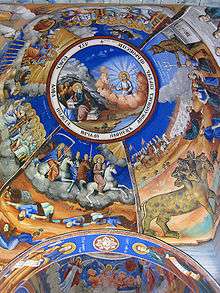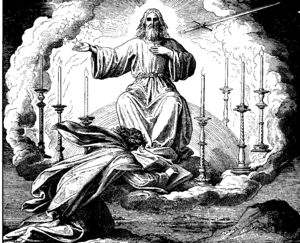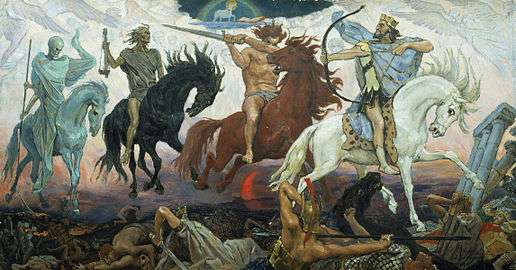Apocalypse
An apocalypse (Ancient Greek: ἀποκάλυψις apokálypsis, from ἀπό and καλύπτω, literally meaning "an uncovering") is a disclosure or revelation of knowledge. In religious and occult concepts an apocalypse usually discloses something hidden, or provides what Bart Ehrman has termed "a vision of heavenly secrets that can make sense of earthly realities".[1] Historically, the term has a heavy religious connotation as commonly seen in the prophetic revelations of eschatology obtained through dreams or spiritual visions. It is thought by certain sects of Christianity that the biblical Book of Revelation depicts as an "apocalypse" the complete and final destruction of the world. However, there is also another interpretation of the Book of Revelation in which the events predicted are said to refer to the destruction of Jerusalem in A.D. 70 by the Roman armies of Titus. This second view is known as the Preterist view of eschatology.
| Part of a series on |
| Eschatology |
|---|
|
|
|
— Figures —
— Events — |
|

In all contexts, the revealed events usually entail some form of an end time scenario or the end of the world – or revelations into divine, heavenly, or spiritual realms. There are many other books from the Jewish and Christian world that can be classified as apocalypses. In addition, other books of the Bible contain passages pertaining to an apocalypse or to apocalyptic circumstances.
Word usage
The Greek word apokálypsis has become particularly associated with the last book of the New Testament entitled "Revelation" and also known as "the Apocalypse" or as "the Apocalypse of John". The term is also included in the title of some non-biblical canon books involving revelations. Today, English-speakers commonly refer to any larger-scale catastrophic event or chain of detrimental events to humanity or nature as "an apocalypse" or as "apocalyptic".
Origin
Dreams and visions


A revelation may be made through a dream, as in the Book of Daniel, or through a vision, as in the Book of Revelation. In biblical terms, a revelation is something shown to humans by God: Other words used to describe revelation include: apocalypse, prophecy, unveiling. Fasting, mainly as part of a spiritual discipline, can lead one into an apocalyptic prophetic vision.[2] One example of this is found in the Book of Daniel which is the first apocalypse in the Protestant Bible.[3] After a long period of fasting,[4] Daniel is standing by a river when a heavenly being appears to him, and the revelation follows (Daniel 10:2ff). Apocalyptic visions or dreams show hidden information/truth about God, human life and the spiritual world. These visions or dreams usually show insights about life after death. A part about Gods final judgement deals with forces of evil and forces of good. In the Bible God defeats an evil force forever and bring justice and mercy to the world. Rev 20–22,[5] and the article “Day of the Lord”
Revelations of the Patriarchs
| Adam | A fall of 5500 years | Adam would be back in the Garden of Eden when the messenger of God (Messiah) will come to save him and his children. | The Book of Adam and Eve (I-chap. 6, 21–25), rev. Malan 1882 |
| Enoch | The ten (10) weeks of the world | It cover the chastisement by the flood until the heavenly dwelling of the righteous (and destruction of the world). | The Book of Enoch (chap. 91–93), prof. Dillmann 1893 |
| The Watchers | Imprisoned for seventy (70) generations | For luring the women and begot wicked giants. | The Book of Jubilees (chap.7), prof. Charles 1902; The Book of Enoch (chap. 10), Dillmann 1893 |
| Noah | Destruction of the children of Cain | Those who go into Sheol (place of condemnation) will be in the darkness of the deep, fully removed into an intense death. | The Book of Jubilees (chap.7), prof. Charles 1902 |
| Abraham | Visions of Heaven and Sheol | The idolater and murderers from his own people. | The Apocalypse of Abraham, Box 1918 |
Symbolism
Numerical
Apocalyptic writing often makes wide use of symbolism. One instance of this occurs where gematria is employed, either for obscuring the writer's meaning or enhancing it; as a number of ancient cultures used letters also as numbers (i.e., the Romans with their use of "Roman numerals"). Thus the symbolic name "Taxo," "Assumptio Mosis", ix. 1; the "Number of the Beast" (616/666), in the Book of Revelation 13:18;[6] the number 666 ('Iησōῦς), Sibyllines, i.326–30.
Lengths of time / periods
Similar is the frequent prophecy of the length of time through which the events predicted must be fulfilled. Thus, the "time, times, and a half," Daniel 12:7 which has been taken to be 3½ years in length by Dispensationalists;[7] the "fifty-eight times" of Enoch, xc.5, "Assumptio Mosis", x.11; the announcement of a certain number of "weeks" or days, which starting point in Daniel 9:24, 25 is "the going forth of the commandment to restore and to build Jerusalem unto the Messiah the Prince shall be seven weeks",[8] a mention of 1290 days after the covenant/sacrifice is broken (Daniel 12:11),[9] 12; Enoch xciii.3–10; 2 Esdras 14:11, 12; Apocalypse of Baruch xxvi–viii; Revelation 11:3, which mentions "two witnesses" with supernatural power,[10] 12:6;[11] compare Assumptio Mosis, vii.1.
Descriptions
Symbolic language also occurs in descriptions of persons, things or events; thus, the "horns" of Daniel 7 and 8;[12] Revelation 17[13] and following; the "heads" and "wings" of 2 Esdras xi and following; the seven seals of Revelation 6;[14] trumpets, Revelation 8;[15] "vials of the wrath of God" or "bowl..." judgments, Revelation 16;[16] the dragon, Revelation 12:3–17,[17] Revelation 20:1–3;[18] the eagle, Assumptio Mosis, x.8; and so on.
Result/purpose

End of the age
In the Hebrew Old Testament some pictures of the end of the age were images of the judgment of the wicked and the glorification of those who were given righteousness before God. In the Book of Job and in some Psalms the dead are described in these Hebrew texts as being in Sheol, awaiting the final judgment. The wicked will then be consigned to eternal suffering in the fires of Gehinnom, or the lake of fire mentioned in the Christian Book of Revelation.[16][19][20][21][22]

See also
References
- Bart D. Ehrman, How Jesus Became God: The Exaltation of a Jewish Preacher from Galilee (New York: HarperOne, 2014), page 59. Quoted in: Gallois, Caroline (2019). William Orpen, an Outsider in France: Painting and Writing World War One. Newcastle upon Tyne: Cambridge Scholars Publishing. p. 112. ISBN 9781527525849. Retrieved January 29, 2019.
- Eggmeier, Matthew (2014). A Sacramental-Prophetic Vision : Christian Spirituality in a Suffering World. Collegeville, MN: Michael Glazier. p. 39. ISBN 9780814680926.
- Carey, Greg (April 2017). "Daniel as an Americanized Apocalypse". Interpretation: A Journal of Bible and Theology. 71 (2): 190–203. doi:10.1177/0020964316688052.
- "Daniel 10:1–4 (King James Version)". Bible Gateway. Retrieved November 15, 2007.
- bible. pp. 20–22.
- "Revelation 13:16–18 (King James Version)". Bible Gateway. 2012. Retrieved November 21, 2007.
- "Daniel 12:7 (King James Version)". Bible Gateway. Archived from the original on December 9, 2007. Retrieved November 21, 2007.
- "Daniel 9:24–25 (King James Version)". Bible Gateway. Retrieved November 21, 2007.
- "Daniel 12:11 (King James Version)". Bible Gateway. Archived from the original on November 5, 2007. Retrieved November 21, 2007.
- "Revelation 11:3 (King James Version)". Bible Gateway. Archived from the original on December 9, 2007. Retrieved November 21, 2007.
- "Revelation 12:6 (King James Version)". Bible Gateway. Archived from the original on December 9, 2007. Retrieved November 21, 2007.
- "Daniel 7; Daniel 8 (King James Version)". Bible Gateway. Archived from the original on December 9, 2007. Retrieved November 21, 2007.
- "Revelation 17 (King James Version)". Bible Gateway. Archived from the original on December 9, 2007. Retrieved November 21, 2007.
- "Revelation 6 (King James Version)". Bible Gateway. Archived from the original on November 15, 2007. Retrieved November 21, 2007.
- "Revelation 8 (King James Version)". Bible Gateway. Archived from the original on December 9, 2007. Retrieved November 21, 2007.
- "Revelation 16 (King James Version)". Bible Gateway. Archived from the original on December 8, 2007. Retrieved November 21, 2007.
- "Revelation 12:3–17 (King James Version)". Bible Gateway. Retrieved November 21, 2007.
- "Revelation 20:1–3 (King James Version)". Bible Gateway. Retrieved November 21, 2007.
- "Revelation 19:20 (King James Version)". Bible Gateway. Archived from the original on November 7, 2007. Retrieved November 21, 2007.
- "Revelation 20:10 (King James Version)". Bible Gateway. Archived from the original on December 9, 2007. Retrieved November 21, 2007.
- "Revelation 20:14–15 (King James Version)". Bible Gateway. Retrieved November 21, 2007.
- "Revelation 21:8 (King James Version)". Bible Gateway. Archived from the original on November 24, 2007. Retrieved November 21, 2007.
Further reading
- Morris, Henry M (1985) [1983]. The Revelation Record. Tyndale House and Creation Life.
- Collins, John J. (2010). The Apocalyptic Imagination: An Introduction to Jewish Apocalyptic Imagination 2nd Ed. Wm. B. Eerdmans Publishing.
- Collins, John J. ed. (2014). The Oxford Handbook of Apocalyptic Literature. Oxford University Press.
- Croley, Wayne (2018). Prophecy Proof: Insights of the end of times.
- Doyle, Arthur (2016). The New Revelation.
External links
- The Apocalypse on In Our Time at the BBC
- "It's the End of the World: 8 Potential Armageddons". Fox. September 29, 2010..
- Bible. N.T. Revelation. Latin. Selections. 1470. Apocalypsis Sancti Johannis. Germany, c. 1470 48 leaves. illus. 31 cm. From the Rare Book and Special Collections Division at the Library of Congress.
- Apocalypses Apocrypha – of the Patriarchs, the Prophets, and the Apostles.
- Sefer of Jesus or Gospel of Barnabi – the seven gates of Sheol (chap. 59–60, 135–137).
